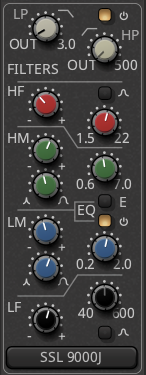Click the “EQ” switch on an Input Strip to expose the EQ controls:
EQ Mode
The EQ ‘mode’ switch allows selection of either the Harrison 32C equalizer, or the SSL 9000J equalizer (Mixbus Pro only)
Harrison 32C Channelstrip EQ & Filters
The default setting for the channelstrip EQ emulates the famous Harrison 32Series EQ, which was used on countless popular albums.
The Channelstrip EQ provides a very wide range of frequency and gain changes ( up to 15dB! ) to help tame your tracks. The high and low bands are shelving filters for general tone sculpting, while the 2 middle bands are “proportional Q” design. Optionally, the High and Low bands may be switched to “bell” ( peaking ) shape with the small mode switches at top and bottom.
Specifications:
Separate “In” buttons for 4-band EQ; 2-band Filter section.
Gain Range +/- 15dB
Frequency Ranges (adjustable):
- HI: approx 900 Hz to 13,000 Hz
- HI MID : approx 400 Hz to 6,000 Hz
- LOW MID: 200 Hz to 3,100 Hz
- LO: 40 Hz to 600 Hz
Filter Frequencies:
LPF 12 dB/octave, frequency range (approx) 160 to 20,000 Hz
HPF 12 dB/octave, frequency range (approx) 20 to 3,100 Hz
NOTE that the filters have a generous frequency overlap. It is possible to adjust the frequency knobs on the filters such that there is NO signal coming through! This was also possible on the original 32C analog console, and was a favorite tactic of control room pranksters.
SSL 9000J Channelstrip EQ & Filters
Mixbus Pro users may select the SSL 9000J equalizer as an alternative to the Harrison 32C equalizer.
The SSL 9000 console was introduced in 1995 and uses SSL’s newly introduced “Superanalogue” circuitry to provide an extended and clean frequency response for the era of high-resolution digital recording and playback.
The SSL 9000J Channelstrip EQ provides a very wide range of frequency and gain changes (up to 20dB) to help tame your tracks. The high and low bands are shelving filters for general tone sculpting, while the 2 middle bands have a “proportional Q” design. Additionally, the 2 middle bands also have a dedicated Q (sharpness) knob. At its widest setting,the proportional-q has little effect, while at the tightest (leftmost) setting, the curve is noticeably sharper and becomes more sensitive to the gain, introducing a noticeably sharper eq when boosted or cut.
Optionally, the High and Low shelving bands may be switched to “bell” ( peaking ) shape with the small mode switches at top and bottom.
By default, the 9KJ shelving bands have a slight resonance which causes an inverse ‘cut’ just before a shelving boost. The “E” button decreases this resonance, making the curves more like the 32C shelves.
Differences between the EQ modes
While similar in many ways to the 32C equalizer, the SSL version has some notable differences.
While both equalizers have 2 sweepable mid-bands, the middle bands of the 9kJ equalizer have more gain (20dB) available than 32C (15dB).
At its default settings, the SSL EQ’s midrange bandwidth is significantly wider than the 32C, and at wider Q settings it is much wider than the 32C, making it suitable for very gentle wide-band tone control. Only at its tightest Q settings and highest boost does the SSL exceed the sharpness of the 32C circuit. Conversely, when switched to Bell mode, the 32C has a wider bandwidth than the SSL bell shapes! These small differences are indicative of their different designers’ goals, and might lead you to choose a different EQ depending on the job at hand.





Post your comment on this topic.